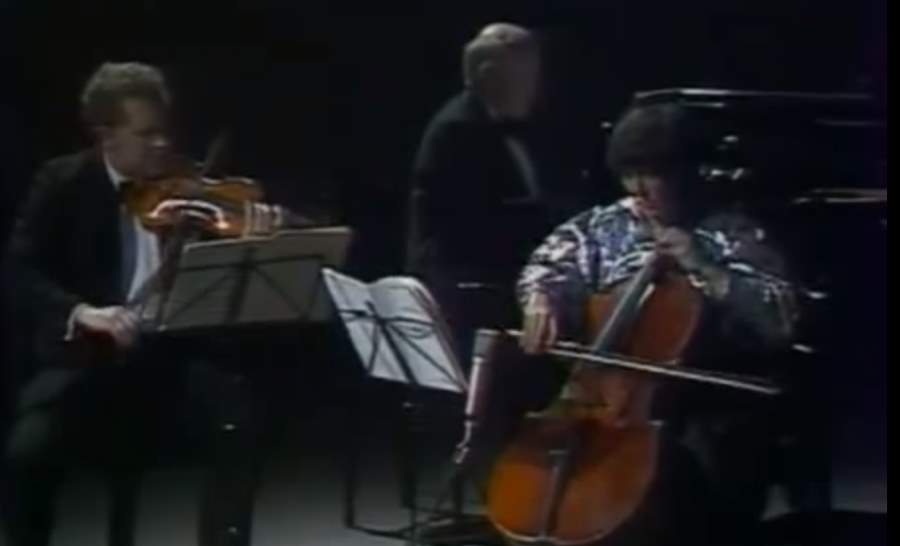Alexandre Kantorow (piano), Liya Petrova (violin), and Aurélien Pascal (cello) perform Pyotr Ilyich Tchaikovsky’s Piano Trio in A minor, Op. 50. This performance was recorded during the Festiv’Elmire 2020.
Pyotr Ilyich Tchaikovsky’s Piano Trio
Tchaikovsky’s Piano Trio in A minor, Op. 50, dedicated to the memory of Nikolai Rubinstein, stands as a monumental work within the chamber music repertoire, embodying deep emotional expression and innovative structural design. Composed in 1881 and 1882, this piece is unique in Tchaikovsky’s output, not only because it is his only piano trio but also due to its substantial length and the depth of its emotional content.
The work is titled “In Memory of a Great Artist,” reflecting Tchaikovsky’s complex relationship with Rubinstein, a friend, mentor, and critic. The trio is notable for its demanding piano part, lush string writing, and the dramatic interplay between the instruments, showcasing Tchaikovsky’s mastery of both melody and harmony.
First Movement: Pezzo elegiaco (Moderato assai – Allegro giusto)
The first movement, “Pezzo elegiaco,” begins with a somber and introspective theme introduced by the piano, soon joined by the strings in a deeply expressive dialogue. This theme sets the tone for the movement, which oscillates between moments of tender lyricism and turbulent passion. The movement is structured in a sonata-allegro form but is infused with a rhapsodic quality that allows for expansive thematic development and emotional exploration.
Tchaikovsky’s use of the piano trio format here is expansive, pushing the boundaries of the genre with the movement’s breadth and the intensity of its expression. The piano often takes on a virtuosic role, delivering cascades of arpeggios and powerful chords, while the violin and cello weave intricate melodic lines that intertwine with the piano’s material. The development section deepens the emotional landscape, exploring the themes in new harmonic and textural contexts, leading to a climax that is both powerful and poignant.
The recapitulation brings back the main themes, now transformed and imbued with a deeper sense of reflection and melancholy. The movement concludes with a coda that revisits the opening material, ending in a quiet, elegiac mood. This movement, with its blend of lyrical beauty and dramatic intensity, sets the stage for the emotional journey of the trio as a whole.
Second Movement: Tema con variazioni
The second and final movement of the trio is a theme and variations, a form that Tchaikovsky employs to remarkable effect. The movement opens with a simple, song-like theme introduced by the cello, which is then taken up by the violin and piano. This theme serves as the foundation for a series of eleven variations, each exploring a different aspect of the theme’s musical and emotional possibilities.
The variations display a wide range of moods and styles, from the virtuosic and flamboyant to the introspective and serene. One variation may feature a delicate interplay of pizzicato strings against a filigree piano line, while another might plunge into the depths of romantic passion with lush, sweeping melodies and rich harmonies. Tchaikovsky’s skill in variation form is evident in his ability to maintain the theme’s identity while exploring diverse musical landscapes.
Notable among the variations is the elegiac variation, which serves as a direct tribute to Nikolai Rubinstein. This variation is characterized by its heartfelt melody and poignant harmonies, reflecting Tchaikovsky’s grief and admiration for his late friend. The finale of the movement, a powerful and dramatic variation, brings the work to a climactic close, combining elements from the previous variations and reintroducing the theme in a grand, triumphant manner.
The second movement, with its rich tapestry of variations, showcases Tchaikovsky’s compositional ingenuity and emotional depth. Through the theme and variations, he crafts a multifaceted musical tribute to Rubinstein, exploring the full spectrum of human emotion and expression. The Piano Trio in A minor, Op. 50, stands as a testament to Tchaikovsky’s mastery of chamber music, a deeply personal and innovative work that remains a cornerstone of the piano trio repertoire.
The variations are as follows:
- Var I
- Var II: Più mosso
- Var III: Allegro moderato
- Var IV: L’istesso tempo (Allegro moderato)
- Var V: L’istesso tempo
- Var VI: Tempo di Valse
- Var VII: Allegro moderato
- Var VIII: Fuga (Allegro moderato)
- Var IX: Andante flebile, ma non tanto
- Var X: Tempo di mazurka
- Var XI: Moderato
- Variazioni finale e coda: Allegro risoluto e con fuoco
- Coda: Andante con moto – Lugubre (L’istesso tempo)
Sources
- Piano Trio (Tchaikovsky) on Wikipedia
- Piano Trio, Op.50 (Tchaikovsky, Pyotr) on the International Music Score Library Project website


